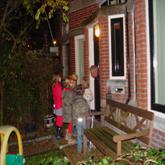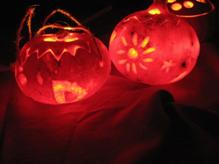

This isn't a general celebration. My Dutch husband was as much in the dark about Sint-Maarten when we moved to Friesland as I was. We used to live in Leiden and Sint-Maarten wasn't celebrated much there.
Luckily, a nice neighbour warned us that we would need to get a supply of sweets because the children that would come round to our house wouldn't be singing songs just to spread a little happiness - they'd want to be paid in sweets too. There doesn't seem to be any tradition of doing nasty things to people who refuse to give you sweets as with Halloween. I did read about a song that children can sing to people who don't give them anything but haven't ever heard it.
The worst thing about Sint-Maarten from a parent's point of view is having to trog round house after house with your children watching as their bags fill up with ridiculous amounts of sweets. In our house the sweets get put in boxes and most of them are spirited away to last us for the rest of the year until the next Sint-Maarten.
Sint-Maarten (or Maartensdag or St. Martin's Day) is the feast day of St Martin, which is 11 November. In the Netherlands, this is celebrated in some, but not all, areas. How exactly it is celebrated depends on the area but there generally tends to be the lampionnentocht , which is a procession with lanterns.
When Sint-Maarten is celebrated depends on the area as well: in some areas, it is the evening of the eleventh, in others it is the evening before and in yet others it is the Friday or Saturday before.
In most areas, children go from door to door with lanterns singing Sint-Maarten songs and are given sweets or fruit. Given a choice, the children will carry on until the weight of the sweets in their rucksacks pulls them over backwards and pins them to the ground and until you as a parent can't bear to hear the same old Sint-Maarten song ever again. Then they come home and expect to eat all the sweets in one go and get stroppy if they can't.
In some areas, there is a church service where the story of Sint-Maarten is told and after which there is a procession with lanterns to a big bonfire.
It depends where you live. If you live in Groningen, Drenthe, Friesland, Noord-Holland, Brabant or Limburg, it's likely Sint-Maarten will be celebrated in your town or village and, unless you do the Halloween trick of turning off all the lights and pretending you're not home, you'll probably have to join in. If you've got kids you won't have a choice.
If you live in other parts of the Netherlands, Sint-Maarten may not be celebrated but it is gaining popularity in a number of areas, such as Amsterdam and Utrecht.
The best thing to do is find a nice local who will tell you if, how and when it is celebrated in your area.
Again, this depends on where you live and how Sint-Maarten is celebrated. If there is a tradition of going round the houses with a lantern and you've got young children, you'll probably have to go with them. If you're lucky they'll do all the singing themselves and you won't need to sing along.
If children go from door to door, you'll need to have a tray of sweets and fruit at home and you'll need to say positive, encouraging things about their singing.
Your child will probably need a lantern, which, if you are lucky, they will make at school, the peuterspeelzaal or nursery. If they don't make them at school, the peuterspeelzaal or nursery, you can buy or make a lantern. If you're in an area where Sint-Maarten is celebrated, your local shops will probably sell lanterns. If you fancy making your own, there are a number of websites with ideas and instructions on how to make lanterns (see links section below).
You will need a light to put in the lantern. If you are in a Sint-Maarten region, your local shops will probably sell these. They look a bit like mini fishing rods with a bulb on the end. If you can't find them in the shops you can order them on the web (see links section below).
If there is a tradition of going round the houses, you will need to get some sweets to offer to children that come to your house. Your local supermarket will probably have a special sweets-for-Sint-Maarten section. You can also try putting out some fruit. We did last year, middle-class parents that we are, and were surprised that it was quite popular. If you only put out a select few pieces of fruit this seems to make it even more attractive.
The most significant story from the life of St Martin seems to be what Wikipedia refers to as The Episode of the Cloak , in which St. Martin, a Roman soldier at the time, gave away half of his cloak to a beggar and that night dreamt of Jesus wearing the half-cloak he had given away.
It also seems likely that the Halloween traditions that began in America (pumpkin lanterns, trick or treating) were rooted in this festival.
Wikipedia also says the following:
From the late 4th century to the late Middle Ages, much of Western Europe, including Great Britain, engaged in a period of fasting beginning on the day after St. Martin's Day, November 11. This fast period lasted 40 days, and was, therefore, called "Quadragesima Sancti Martini," which means in Latin "the forty days of St. Martin." At St. Martin's eve and on the feast day, people ate and drank very heartily for a last time before they started to fast. This fasting time was later called "Advent" by the Church.
- Lampion - lantern
- Lampionnentocht - procession with lanterns
- Lampionstok - stick with light on it to put in the lantern
- Vreugdevuur - bonfire
- Troshoop - another name for the bonfire
- 'Heel mooi gezongen, hoor!' - 'lovely singing'
- 'Leuk! Goed gedaan!' - 'lovely, well done!'
- Snoep - sweets
If you're lucky they'll have learnt them at school, the peuterspeelzaal or nursery. Here's the words of the two songs my children know:
Sint Maarten Sint Maarten
Sint Maarten Sint Maarten
De koeien hebben staarten
De meisjes hebben rokjes aan
Daar komt Sint Martinus aan
11 november is de dag
11 november is de dag
dat mijn lichtje,
dat mijn lichtje.
11 november is de dag,
dat mijn lichtje schijnen mag